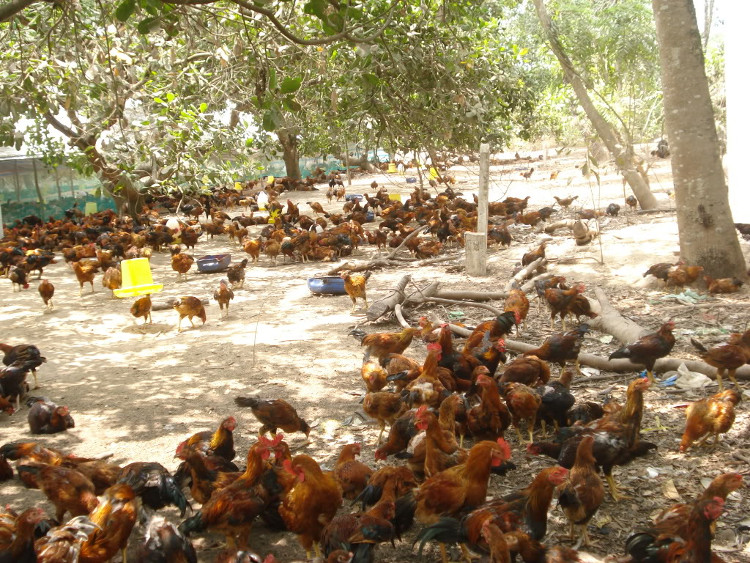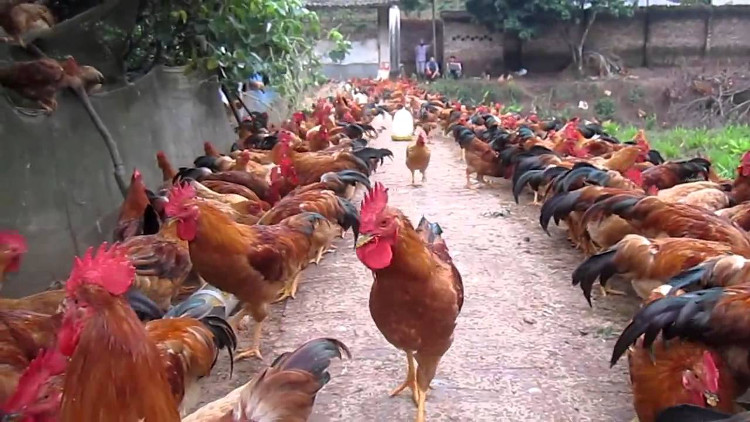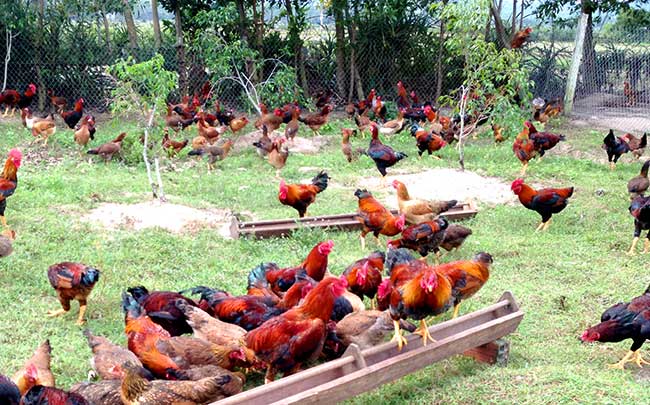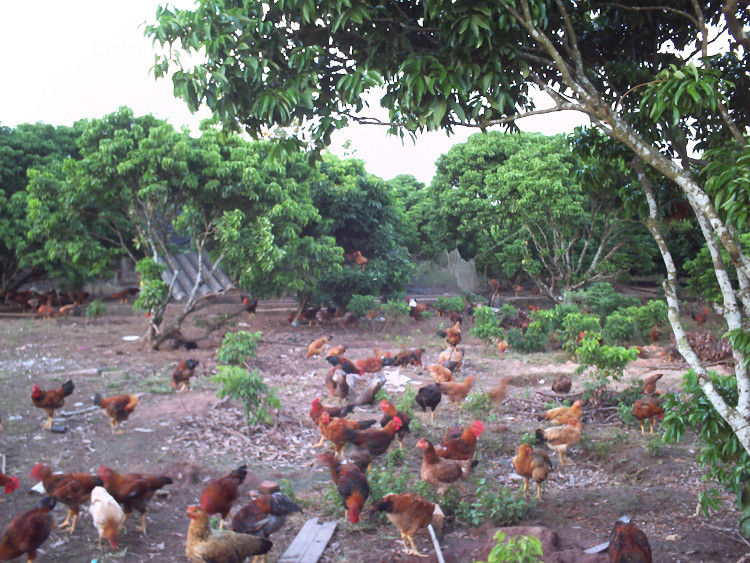Guide the technique of raising chickens in our garden is highly effective
Guide the technique of raising chickens in our garden is highly effective
The free-range chicken raising model is developing strongly in many localities throughout the country. Initially, the model has brought high efficiency to many raising households.
Raising chickens in our garden is not difficult, but to successfully raise chickens to bring optimal economic efficiency, breeders must learn techniques, regularly consult the press, experience of the forerunners. in practice in household farming.
To contribute to helping you raise backyard chickens effectively, we would like to introduce some important steps in the technique of raising backyard chickens for your reference.
1. Preparation of farming conditionsBefore bringing our chickens to raise, it is necessary to prepare all material and technical conditions such as:
Breeding cages, curtains, cranks, heating hoods, feeding troughs, drinking troughs. All must be disinfected before use from 5-7 days.
Prepare all necessary food and veterinary medicine for the chicken flock.
The cage ensures coolness in the summer, and warmth in the winter.
The barn floor is technically designed, high, and drained.
Filler: Rice husks, clean shavings, 5cm -10cm thick are sprayed with antiseptic when used.
Ensure air circulation in the barn.

Raising chickens in our garden is not difficult.
Prepare the barn
Choose a high, airy area to store the chicken coop. The cage should be stored in the East or Southeast direction to catch the morning sun and avoid the afternoon sun.If rearing completely in captivity, pay attention to the appropriate stocking density (8 chickens/m 2 if broilers are raised on the floor, 10 chickens/m2 if broilers are raised on the ground).
If raising chickens in the garden, the coop is a place to avoid rain and sun and sleep at night, the density of the garden to raise chickens is at least 1 chicken/m 2 .
The front door of the barn faces southeast. The floor of the barn is made of thin mesh or bamboo 0.5 m above the ground for ventilation, dryness, and easy cleaning.
Fencing around the garden with B40 net, nylon net, wooden bamboo... depending on the farming conditions of each household. During the day, the chickens are dry and released to the yard and garden to play, and in the evening, the chickens are returned to the coop.
Preparing the incubator for the chicksSize 2m x 1m height 0.5m feet enough to feed 100 chickens.
Heat the chickens with lamps (two 75 W bulbs for 100 chickens).
Prepare the feederWhen chickens are young (1-3 days old) spread broken bran on paper lined in the brooder to feed the chickens.
When chickens are 4-14 days old, feed them with a chick feeder.
For more than 15 days, feed chickens with hanging troughs.
Prepare the drinkerPlace or hang alternate drinking and feeding troughs in the garden. Change clean water for chickens 2-3 times/day.
Prepare a sand bath, a gravel trough for chickensChickens love to bathe in the sand.
For grazing chickens, it is necessary to build a sand storage tank, kitchen ash and living quarters for chickens to bathe. The size of the tank is 2m long, 1m wide, 0.3m high for 40 chickens.
Put some sand, gravel or small rocks around the grazing place for the chickens to eat, to help the chickens digest the food better.
Preparing the chicken for the chickenChickens have a habit of sleeping on high at night to avoid predators and keep their feet moist, avoiding infection. Therefore, it is advisable to create a number of perches for the chickens to sleep in the coop.
The perch is made of bamboo and wood (should not be made of round trees because it is difficult for chickens to perch). Seamless about 0.5m from the floor of the cage, 0.3-0.4m apart so that the chickens don't touch each other, peck each other and poop on each other.
Make a nest for chickens in a dark place. One nest for 5-10 hens.
Grazing garden: 1m 2 / 1 chicken.

If raising for meat, choose Golden Chinese chicken, Dong Tao chicken...
Construction of grazing grounds
When raising chickens in a new style, in order to build grazing grounds effectively, people need to choose a place with open land and lots of shade. In addition, in the barn should add green grass to make food for animals. If possible, invest in drinking troughs and feeders for chickens.

Chicken grazing yard.
The grazing area should be large enough for chickens to easily move and find food. Normally, the minimum area to be implemented will be from 0.5 to 1m 2 /head. If you own a large land area, you can arrange 2 grazing yards with cages in the center.
Like the construction of a barn, the grazing yard also needs to meet the requirements of easy drainage, flatness, no foreign objects, garbage, standing water, and periodic collection of feathers on the pasture. At the grazing position, it is necessary to use a barrier made of bamboo or B40 steel to ensure that the chickens do not walk and wild animals cannot enter.
2. Choose chicken breeds we let in our gardenRaising our chickens in the direction of meat: Choose Chinese chicken breeds, Dong Tao chickens, Noi chickens, Tam Hoang chickens, Luong Phuong chickens, Ho chickens, hybrid chickens...
Raising our chickens in the direction of getting commercial eggs: Choose chicken breeds that lay a lot like Tau Vang chicken, Tam Hoang chicken, BT1 chicken, Ri chicken,....
* Select breed chicks:Choose chicks that are as uniform in weight as possible.
Choose the fast, bright eyes, fluffy feathers, compact belly, fat legs.
Avoid choosing chickens with dry legs, crooked beaks, club legs, open navel, sagging belly, hairy holes, sagging wings, and dark circles around the navel.
* Select breeding hens:Choose a baby whose weight is not too low, not too fat, at 20 weeks old reaching 1.6-1.7 kg is very good.
The head is small, the beak is short, the mouth is large, bright red.
Bright eyes, smooth hair arranged close to the body, soft developed belly.
The anus is wide, bright pink and moist.
The distance between the pelvis and the sternum is about 3-4 fingers wide, between the two pelvises is nearly 2-3 fingers wide.
3. Nurturing care techniquesIt is recommended to transport chicks in the early morning or cool afternoon, avoiding rainy days or tropical depressions. Put the chickens in the brooder, give the chickens water mixed with Electrotyle or Vitamin C, only feed the chickens with cooked or broken pieces, and soaked corn puree after the chickens hatch for at least 12 hours, continue to feed like that for up to 2 days. On the third day, mix with increasing amounts of industrial feed or mix by-products yourself.
Mix coccidiosis in chicken feed from day 7 onwards, use Rigecoccin 1 gr/10 kg of feed (or use Sulfamid mixed at 5% rate). Change the bottom lining paper and clean the manure every day.
Wash the feeders and drinkers clean, observe the eating and walking status of the chickens, if you see any sad or moody chicks, they should be isolated immediately for monitoring.
Use a 75W round light bulb for 1m2 of sheltered barn to keep heat, depending on the weather, increase or decrease the amount of heat by raising or lowering the height of the bulb.
It is observed that if the chickens are gathered around the light bulb, the chickens are cold, if they are far away from the light, they are hot, if the chickens are gathered in the corner of the coop, they will be drafted and the chickens will be able to move around and eat and drink freely. chickens in the brooding stage to prevent mice and cats and let the chickens eat more food.
Regularly observe the expression of chickens to promptly handle any abnormalities that occur. When the weather changes, chickens should drink water mixed with Electrolyte or Vitamin C.
Due to the habit of our chickens often drinking water at the same time as eating, it is advisable to put the feeder and the drinker next to each other so that the chickens can drink enough water without drinking dirty water in the garden.
If it is a broiler chicken, there is no need to cut the beak. For laying hens to reduce pecking, the beak should be cut off (only the horn part of the beak) at 6-7 weeks.
Note: Do not raise many chicken sizes in one coop, before raising the new batch, it is necessary to disinfect the entire barn and tools.
4. Chicken feedFree-range chickens are one of the sensitive animals, so absolutely do not feed your chickens with food that is rancid, infected with fungus, or rotting.
It is possible to use industrial feed or make use of agricultural by-products to ensure the following ingredients: Energy, protein, minerals and vitamins. Control the amount of feed and ensure the quality of feed for pullets so that the chickens do not become fat and reduce egg production.
For free-range chickens, mineral and vitamin issues are not as important as chickens that we raise in captivity, because they will search for themselves according to the body's needs.
After the incubation period, chickens can eat more green vegetables. Should raise more earthworms and maggots is a rich source of protein for chickens.
On the first day, only feed the chickens with water, eat broken pieces or pureed corn. Feed a little each time to keep the food delicious and stimulate the appetite of chickens.
In the following days, practice gradually feeding chickens to industrial feed. Feed chickens many meals a day, eat freely.
If using a hanging trough to feed chickens, you must regularly monitor and adjust the height of the trough so that the chickens can eat comfortably and avoid dropping food.
Drinking water must be clean and sufficient for chickens to drink, chickens live longer without food than without water.

The cages and the stocking garden must always be dry, clean, and not allow stagnant water in the stocking garden.
5. Hygiene of disease preventionHygiene and prevention is the main task, ensuring "Clean eating, clean living, clean drinking". Therefore, the barn and the stocking garden must always be dry, clean, and not allow stagnant water in the stocking garden.
Strictly apply the vaccination schedule depending on each locality. In addition, using antibiotics to prevent some bacterial diseases, especially for chickens in the background, it is necessary to prevent coccidiosis when putting them on the ground and in the garden.
Causes of illness
Our chickens are still young, chickens are weak, like chickens with a cold.
Habitat:Unbalanced feed can easily make animals sick.
Drinking water is not clean.
The air, the temperature is not suitable....
The resistance of the chicken bodyEvery animal has a mechanical barrier to protect itself.
Human-made resistance by vaccination against diseases (active resistance).
Hygiene measures to prevent disease
* Hygiene of disease prevention:Good food.
Clean water.
Breeds have a high resistance to disease.
Clean cage.
Around the barn must be cleared.
Good implementation of veterinary procedures on hygiene and disease prevention.
* Prevention by Vaccine:Notes when using vaccines to prevent disease:
Use only when the flock is healthy.
Shake vaccine well before and during administration.
Opened vaccine is only used for the day, excess must be destroyed.
Use vitamins to increase nutrition for chickens.
Prepare the barn
Choose a high, airy area to store the chicken coop. The cage should be stored in the East or Southeast direction to catch the morning sun and avoid the afternoon sun.If rearing completely in captivity, pay attention to the appropriate stocking density (8 chickens/m 2 if broilers are raised on the floor, 10 chickens/m2 if broilers are raised on the ground).
If raising chickens in the garden, the coop is a place to avoid rain and sun and sleep at night, the density of the garden to raise chickens is at least 1 chicken/m 2 .
The front door of the barn faces southeast. The floor of the barn is made of thin mesh or bamboo 0.5 m above the ground for ventilation, dryness, and easy cleaning.
Fencing around the garden with B40 net, nylon net, wooden bamboo... depending on the farming conditions of each household. During the day, the chickens are dry and released to the yard and garden to play, and in the evening, the chickens are returned to the coop.
Preparing the incubator for the chicksSize 2m x 1m height 0.5m feet enough to feed 100 chickens.
Heat the chickens with lamps (two 75 W bulbs for 100 chickens).
Prepare the feederWhen chickens are young (1-3 days old) spread broken bran on paper lined in the brooder to feed the chickens.
When chickens are 4-14 days old, feed them with a chick feeder.
For more than 15 days, feed chickens with hanging troughs.
Prepare the drinkerPlace or hang alternate drinking and feeding troughs in the garden. Change clean water for chickens 2-3 times/day.
Prepare a sand bath, a gravel trough for chickensChickens love to bathe in the sand.
For grazing chickens, it is necessary to build a sand storage tank, kitchen ash and living quarters for chickens to bathe. The size of the tank is 2m long, 1m wide, 0.3m high for 40 chickens.
Put some sand, gravel or small rocks around the grazing place for the chickens to eat, to help the chickens digest the food better.
Preparing the chicken for the chickenChickens have a habit of sleeping on high at night to avoid predators and keep their feet moist, avoiding infection. Therefore, it is advisable to create a number of perches for the chickens to sleep in the coop.
The perch is made of bamboo and wood (should not be made of round trees because it is difficult for chickens to perch). Seamless about 0.5m from the floor of the cage, 0.3-0.4m apart so that the chickens don't touch each other, peck each other and poop on each other.
Make a nest for chickens in a dark place. One nest for 5-10 hens.
Grazing garden: 1m 2 / 1 chicken.

If raising for meat, choose Golden Chinese chicken, Dong Tao chicken...
Construction of grazing grounds
When raising chickens in a new style, in order to build grazing grounds effectively, people need to choose a place with open land and lots of shade. In addition, in the barn should add green grass to make food for animals. If possible, invest in drinking troughs and feeders for chickens.

Chicken grazing yard.
The grazing area should be large enough for chickens to easily move and find food. Normally, the minimum area to be implemented will be from 0.5 to 1m 2 /head. If you own a large land area, you can arrange 2 grazing yards with cages in the center.
Like the construction of a barn, the grazing yard also needs to meet the requirements of easy drainage, flatness, no foreign objects, garbage, standing water, and periodic collection of feathers on the pasture. At the grazing position, it is necessary to use a barrier made of bamboo or B40 steel to ensure that the chickens do not walk and wild animals cannot enter.
2. Choose chicken breeds we let in our gardenRaising our chickens in the direction of meat: Choose Chinese chicken breeds, Dong Tao chickens, Noi chickens, Tam Hoang chickens, Luong Phuong chickens, Ho chickens, hybrid chickens...
Raising our chickens in the direction of getting commercial eggs: Choose chicken breeds that lay a lot like Tau Vang chicken, Tam Hoang chicken, BT1 chicken, Ri chicken,....
* Select breed chicks:Choose chicks that are as uniform in weight as possible.
Choose the fast, bright eyes, fluffy feathers, compact belly, fat legs.
Avoid choosing chickens with dry legs, crooked beaks, club legs, open navel, sagging belly, hairy holes, sagging wings, and dark circles around the navel.
* Select breeding hens:Choose a baby whose weight is not too low, not too fat, at 20 weeks old reaching 1.6-1.7 kg is very good.
The head is small, the beak is short, the mouth is large, bright red.
Bright eyes, smooth hair arranged close to the body, soft developed belly.
The anus is wide, bright pink and moist.
The distance between the pelvis and the sternum is about 3-4 fingers wide, between the two pelvises is nearly 2-3 fingers wide.
3. Nurturing care techniquesIt is recommended to transport chicks in the early morning or cool afternoon, avoiding rainy days or tropical depressions. Put the chickens in the brooder, give the chickens water mixed with Electrotyle or Vitamin C, only feed the chickens with cooked or broken pieces, and soaked corn puree after the chickens hatch for at least 12 hours, continue to feed like that for up to 2 days. On the third day, mix with increasing amounts of industrial feed or mix by-products yourself.
Mix coccidiosis in chicken feed from day 7 onwards, use Rigecoccin 1 gr/10 kg of feed (or use Sulfamid mixed at 5% rate). Change the bottom lining paper and clean the manure every day.
Wash the feeders and drinkers clean, observe the eating and walking status of the chickens, if you see any sad or moody chicks, they should be isolated immediately for monitoring.
Use a 75W round light bulb for 1m2 of sheltered barn to keep heat, depending on the weather, increase or decrease the amount of heat by raising or lowering the height of the bulb.
It is observed that if the chickens are gathered around the light bulb, the chickens are cold, if they are far away from the light, they are hot, if the chickens are gathered in the corner of the coop, they will be drafted and the chickens will be able to move around and eat and drink freely. chickens in the brooding stage to prevent mice and cats and let the chickens eat more food.
Regularly observe the expression of chickens to promptly handle any abnormalities that occur. When the weather changes, chickens should drink water mixed with Electrolyte or Vitamin C.
Due to the habit of our chickens often drinking water at the same time as eating, it is advisable to put the feeder and the drinker next to each other so that the chickens can drink enough water without drinking dirty water in the garden.
If it is a broiler chicken, there is no need to cut the beak. For laying hens to reduce pecking, the beak should be cut off (only the horn part of the beak) at 6-7 weeks.
Note: Do not raise many chicken sizes in one coop, before raising the new batch, it is necessary to disinfect the entire barn and tools.
4. Chicken feedFree-range chickens are one of the sensitive animals, so absolutely do not feed your chickens with food that is rancid, infected with fungus, or rotting.
It is possible to use industrial feed or make use of agricultural by-products to ensure the following ingredients: Energy, protein, minerals and vitamins. Control the amount of feed and ensure the quality of feed for pullets so that the chickens do not become fat and reduce egg production.
For free-range chickens, mineral and vitamin issues are not as important as chickens that we raise in captivity, because they will search for themselves according to the body's needs.
After the incubation period, chickens can eat more green vegetables. Should raise more earthworms and maggots is a rich source of protein for chickens.
On the first day, only feed the chickens with water, eat broken pieces or pureed corn. Feed a little each time to keep the food delicious and stimulate the appetite of chickens.
In the following days, practice gradually feeding chickens to industrial feed. Feed chickens many meals a day, eat freely.
If using a hanging trough to feed chickens, you must regularly monitor and adjust the height of the trough so that the chickens can eat comfortably and avoid dropping food.
Drinking water must be clean and sufficient for chickens to drink, chickens live longer without food than without water.

The cages and the stocking garden must always be dry, clean, and not allow stagnant water in the stocking garden.
5. Hygiene of disease preventionHygiene and prevention is the main task, ensuring "Clean eating, clean living, clean drinking". Therefore, the barn and the stocking garden must always be dry, clean, and not allow stagnant water in the stocking garden.
Strictly apply the vaccination schedule depending on each locality. In addition, using antibiotics to prevent some bacterial diseases, especially for chickens in the background, it is necessary to prevent coccidiosis when putting them on the ground and in the garden.
Causes of illness
Our chickens are still young, chickens are weak, like chickens with a cold.
Habitat:Unbalanced feed can easily make animals sick.
Drinking water is not clean.
The air, the temperature is not suitable....
The resistance of the chicken bodyEvery animal has a mechanical barrier to protect itself.
Human-made resistance by vaccination against diseases (active resistance).
Hygiene measures to prevent disease
* Hygiene of disease prevention:Good food.
Clean water.
Breeds have a high resistance to disease.
Clean cage.
Around the barn must be cleared.
Good implementation of veterinary procedures on hygiene and disease prevention.
* Prevention by Vaccine:Notes when using vaccines to prevent disease:
Use only when the flock is healthy.
Shake vaccine well before and during administration.
Opened vaccine is only used for the day, excess must be destroyed.
Use vitamins to increase nutrition for chickens.
Nhận xét
Đăng nhận xét